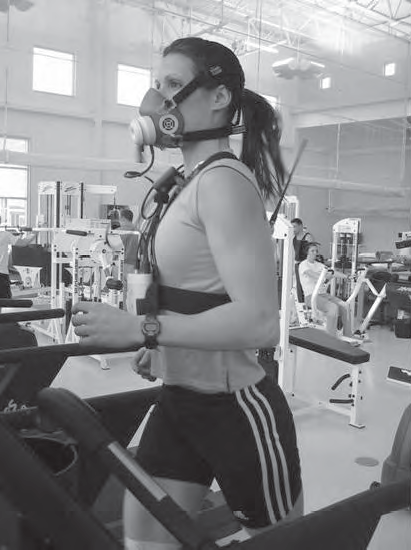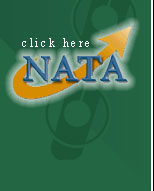|
PRACTICAL
SIGNIFICANCE
Running
mechanics
may not
change
despite
the
onset of
fatigue.
However,
compensatory
muscle
activation
may
exist
resulting
in an
increased
potential
for
overuse
injury.
STUDY
BACKGROUND
Due to
the
repetitive
nature
of
running,
dissipation
of the
encountered
forces
requires
a proper
coordination
of the
segments
of the
lower
extremity.
The lack
of
coordinated
movement
between
knee
flexion
and
pronation
will
result
in a
torsional
force
about
the knee
and
ankle as
tibial
rotation
occurs
concomitantly
with
sagittal
plane
knee
motion
and
frontal
plane
ankle
motion
OBJECTIVE
The
purpose
of this
study
was to
determine
if
running-related
fatigue
disrupts
knee
flexionpronation
synchrony
and
results
in
decreased
shock
attenuation
in
healthy,
competitive
male and
female
distance
runners.
DESIGN
AND
SETTING
A
within-subject,
repeated
measures
design
was
utilized
for this
study.
The
single
independent
variable
was
condition
(fatigue,
no
fatigue).
The
study
took
place in
a
university
research
laboratory.
SUBJECTS
Twelve
healthy,
competitive
male and
female
distance
runners
(age
24.5 ±
4.1 y,
ht 1.74
± .09,
mass
65.15 ±
9.82 kg
participated.
Subjects
were
competitive
distance
runners
(>1500
m) with
no
history
of
musculoskeletal
injury
within
three
months
prior to
testing.
MEASUREMENTS
Subjects
reported
for two
testing
sessions.
During
session
1,
subjects
performed
a
maximal
oxygen
uptake
test to
determine
anaerobic
threshold
and
corresponding
heart
rate.
For test
session
2,
subjects
performed
an
exhaustive
run at
anaerobic
threshold
pace
that was
determined
from the
maximal
oxygen
uptake
test
(figure).
During
this
test,
knee
flexionpronation
synchrony,
maximum
knee
flexion
angle,
maximum
pronation
angle,
time to
maximum
knee
flexion,
time to
maximum
pronation,
shank
acceleration,
head
acceleration,
and
shock
attenuation
measures
were
calculated
before
and
after
exhaustion.
RESULTS
No
significant
differences
were
demonstrated
in knee
flexionpronation
synchrony
(Pre:
13.8 ±
48.1 ms;
Post:
18.9 ±
37.2
ms),
maximum
knee
flexion
(Pre:
49.3 ±
6.6°;
Post:
49.2 ±
6.2°),
maximum
pronation
(Pre:
9.2 ±
5.1°;
Post:
9.7 ±
6.2°),
time to
maximum
knee
flexion
(Pre:
106.1 ±
22.7 ms;
Post:
117.7 ±
20.4
ms),
time to
maximum
pronation
(Pre:
92.2 ±
48.5 ms;
Post:
98.7 ±
46.9
ms),
shank
acceleration
(Pre:
7.5 ±
1.24 G;
Post:
7.58 ±
1.28 G),
head
acceleration
(Pre:
2.66 ±
0.35 G;
Post:
2.73 ±
0.47 G),
or shock
attenuation
(Pre:
0.63 ±
0.08;
Post:
0.63 ±
0.09)
CONCLUSIONS
Despite
subjective
termination
of the
anaerobic
threshold
run due
to
exhaustion,
the lack
of
differences
between
pre and
post
exhaustion
measures
may have
resulted
from
compensatory
muscle
activation.
This may
allow
subjects
to
continue
running
in a
fatigued
state
without
alterations
in joint
kinematics
and
shock
attenuation
strategies.

Figure.
Experimental
setup of
subject
performing
the
treadmill
exhaustive
run.
|
Publication
and
Presentation
List:
-
Abt
JP,
Myers
JB,
Burdett
RG,
Lephart
SM.
Knee
flexionpronation
synchrony
during
an
exhaustive
run
Journal
of
Athletic
Training.
2005
(suppl);40:S91.
|
|

John P. Abt, PhD, ATC
Principal Investigator
|
|
John Abt completed his Ph.D from the University of Pittsburgh. Currently, he is a
Visiting Assistant Professor in the
Department of Sports Medicine and Nutrition within the School of Health and Rehabilitation Sciences at the University of Pittsburgh where his main research interests interests and current ongoing projects include several studies aimed at female anterior cruciate ligament injury prevention, knee biomechanics during athletic tasks, cycling performance, core stability in cyclists, and injury prevention in military populations |
| |
Neuromuscular Research Laboratory
3200 South Water Street
Pittsburgh, PA 15203
jpast16@pitt.edu
412-432-3800 |
|
|
This Grant Information Summary may be downloaded in a 2-page pdf file from http://www.natafoundation.org/pdfs/AbtJohn.pdf. |
Back to May 23, 2007
eBlast
Newsletter
Send e-mail
to johno@nata.org with questions
or
comments
about this web site. |


